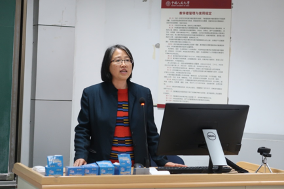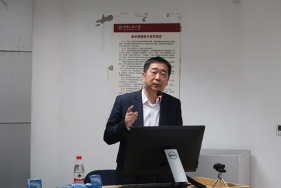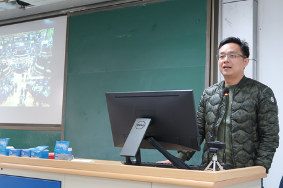Tao Xiang International Finance Lectures (No. 19): Development Path of Contemporary China’s Derivatives Market
2020-11-04 IMIOn the afternoon of October 25, chaired by Tu Yonghong, deputy director of IMI and professor of the School of Finance at RUC, the No. 19th Tao Xiang International Finance Lectures was held at Room 1303, Public Teaching Building 1, Renmin University of China (RUC). Feng Bo, secretary general of the Derivative Finance 50 Forum and chairman of the International Financial Derivatives Consulting Company, delivered a speech on the theme “Development Path of Contemporary China’s Derivatives Market”. Attendees included Guo Biao, associate professor of the School of Finance at RUC, and students from the School of Finance.
Mr. Feng began his speech by sharingsome observations about his experience as a studentand more than 30 years’ practice in the market. Then, he briefed onthe development and regulation historyof various derivatives on China’s market. When contrasting the development path of derivatives market in China with that in theUSand European, Feng noted that China’s derivatives market was born out of reform and opening upand isdominated by the government, reflecting China’s transition from planned economy to socialist market economy.
As forthe distribution of derivatives trading worldwide, Feng observed that derivatives trades inOTCmarkets is about 10 times the size of those on exchanges. Exchange tradingand OTC trading are interdependent while distinct from each other. The exchange-traded market is more standardized and liquid with diverse participants and a uniformand fair pricing mechanism; it relies on external supervision forrisk control. OTC market, in contrast, is composed of institutional players with multi-layered participation,characterized by personalized products with varied prices;instead of external supervision, it relies on internal control.
At last, Mr. Feng Bo analyzed the development path of the current derivatives market with “insurance plus futures” as an example. “Insurance Plus Futures” refers to the business model in which farmersor agricultural companies purchase futures price insurance from insurance companies to hedge against risks amid price fluctuations, insurance companies transfer risks by purchasing OTC options from futures business institutions, and futures business institutions resort to futures markets to hedge against risks. It has set a model for efficiently addressing agricultural problems and serving the real economy through cross-sector cooperation between insurance and futures. In fact, “insurance plus futures” modelcombines theexchange and OTC market. It showcases howOTC market can serve the real economy, providing a new way for the futures market and the spot market (electronic platform) to serve the industry collaboratively. From serving “thousands of households and villages” to serving “thousands of enterprises” to the “insurance plus futures” model and the OTC platform, exchanges are at the forefront of the industry in giving full play to the futures market’s rolein serving the real economy. Through alignment with local commodity trading platforms, exchangescan better serve enterprises in real economy,covering pilot sectorsand the whole industrial chain, opening up the “last mile” for futures to serve real economy. In addition, Fengunderlined the importance of the market, and stressed that we should have faith in and harness the power of the market. Finally, hesenthis best wishes to the studentswho will work in the financemarket.
After that, Professor Tu Yonghong summarized and emphasized two key points in Mr. Feng’s speech. First, the original aspiration of serving farmers, serving enterprises and being practical; and second, respectingand believing in the market. Mr. Guo Biao introduced the development of China’s derivatives market, shared some of his opinions, and paid tribute to his predecessors.
In the Q&A session, Mr. Feng Bo answered questions from some students about government subsidies to alleviate the heavy premium in the “insurance plus futures” model, and the balance between market economy and state-owned industries.



